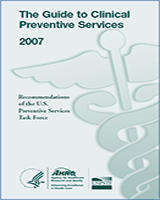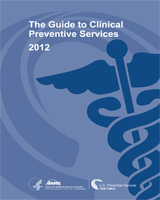NCBI Bookshelf. A service of the National Library of Medicine, National Institutes of Health.
US Preventive Services Task Force. The Guide to Clinical Preventive Services 2007: Recommendations of the U.S. Preventive Services Task Force. Rockville (MD): Agency for Healthcare Research and Quality (US); 2007 Sep.
This publication is provided for historical reference only and the information may be out of date.

The Guide to Clinical Preventive Services 2007: Recommendations of the U.S. Preventive Services Task Force.
Show detailsScreening for Bacterial Vaginosis in Pregnancy
Summary of Recommendations
The U.S. Preventive Services Task Force (USPSTF) concludes that the evidence is insufficient to recommend for or against routinely screening high-risk pregnant women for bacterial vaginosis (BV). (See Clinical Considerations for discussion of populations at high risk.) Rating: I Recommendation.
The USPSTF recommends against routinely screening average-risk asymptomatic pregnant women for BV. Rating: D Recommendation.
Clinical Considerations
- For women with a history of preterm delivery, screening for BV is an option. A single previous episode of preterm delivery by itself may not reliably identify a population of women who will benefit from screening and treatment. Nevertheless, screening may be appropriate in specific circumstances. Studies demonstrating a benefit of screening and treatment were performed among populations of women at especially high risk (35% to 57%) of preterm birth. Clinicians should consider previous history of preterm delivery, other risk factors, and time of presentation in making the decision whether or not to screen for BV in women at high risk.
- For clinicians electing to screen high-risk women, the optimal screening test is not certain. Accepted clinical criteria for BV include vaginal pH >4.5, amine odor on the application of KOH, appearance of a homogeneous vaginal discharge, and presence of clue cells on a microscopic examination of a wet mount. Presence of at least 3 of these 4 criteria is generally considered diagnostic of BV. The use of more limited criteria (e.g., clue cells alone) has not been evaluated.
- Neither the optimal time to screen high-risk pregnant women nor the optimal treatment regimen for pregnant women with BV is clear. The 3 trials that demonstrated a reduction in preterm birth screened in the second trimester (13 to 24 weeks of pregnancy) used various regimens of oral metronidazole alone or oral metronidazole and erythromycin.
- Treatment is appropriate for pregnant women with symptomatic BV infection. These women were excluded from most screening trials and may be at higher risk than those without symptoms. Treatment can relieve symptoms such as vaginal discharge.
This USPSTF recommendation was first published in: Am J Prev Med. 2001;20(3S):59–61.
Behavioral Interventions to Promote Breastfeeding
Summary of Recommendations
The U.S. Preventive Services Task Force (USPSTF) recommends structured breastfeeding education and behavioral counseling programs to promote breastfeeding. Rating: B Recommendation.
The USPSTF found insufficient evidence to recommend for or against the following interventions to promote breastfeeding: brief education and counseling by primary care providers; peer counseling used alone and initiated in the clinical setting; and written materials, used alone or in combination with other interventions. Rating: I Recommendation.
Clinical Considerations
- Effective breastfeeding education and behavioral counseling programs use individual or group sessions led by specially trained nurses or lactation specialists, usually lasting 30 to 90 minutes. Sessions generally begin during the prenatal period and cover the benefits of breastfeeding for infant and mother, basic physiology, equipment, technical training in positioning and latch-on techniques, and behavioral training in skills required to overcome common situational barriers to breastfeeding and to garner needed social support.
- Hospital practices that may help support breastfeeding include early maternal contact with the newborn, rooming-in, and avoidance of formula supplementation for breastfeeding infants.
- Commercial discharge packs provided by hospitals that include samples of infant formula and/or bottles and nipples are associated with reducing the rates of exclusive breastfeeding.
- Mothers who wish to continue breastfeeding after returning to work, especially those working full-time, may need to use an electric or mechanical pump to maintain a sufficient breast milk supply.
- Few contraindications to breastfeeding exist. In developed countries, infection with human immunodeficiency virus (HIV) in the mother is considered a contraindication to breastfeeding, as is the presence of current alcohol and drug use/dependence. Some medications (prescription and non-prescription) are contraindicated or advised for use “with caution” and appropriate clinical monitoring among lactating women.1 Clinicians should consult appropriate references for information on specific medications, including herbal remedies.
This USPSTF recommendation was first published in: Am J Fam Med. 2003;1(2):79–80.
Reference
- 1.
- American Academy of Pediatrics and American College of Obstetricians and Gynecologists. Guidelines for Perinatal Care, 5th ed. October 2002:220–229.
Screening for Gestational Diabetes Mellitus
Summary of Recommendation
The U.S. Preventive Services Task Force (USPSTF) concludes that the evidence is insufficient to recommend for or against routine screening for gestational diabetes. Rating: I Recommendation.
Clinical Considerations
- Better quality evidence is needed to determine whether the benefits of screening for gestational diabetes mellitus (GDM) outweigh the harms. Until such evidence is available, clinicians might reasonably choose either not to screen at all or to screen only women at increased risk for GDM.
- Patient characteristics most strongly associated with increased risk for GDM include maternal obesity (usually defined as a body mass index [BMI] of 25 or more), older age (usually defined as older than 25 years), family or personal history of diabetes, or a history of GDM in a prior pregnancy. Expert groups have also identified certain ethnic groups as being at increased risk for GDM (such as Hispanic, African American, American Indian, and South or East Asian). Using all the above criteria, however, would identify 90 percent of all pregnant women as being at increased risk for GDM.
- The optimal approach to screening and diagnosis is uncertain. Expert panels in the United States recommend a 50-g 1-hour glucose challenge test (GCT) at 24 to 28 weeks' gestation, followed by a 100-g 3-hour oral glucose tolerance test (OGTT) for women who screen positive on the GCT. Different screening and diagnostic strategies recommended by the World Health Organization (WHO) are commonly used outside of North America. The American Diabetes Association (ADA) and the WHO have published specific criteria for diagnosis, but the USPSTF could not determine the relative benefits of any specific approach.1,2
This USPSTF recommendation was first published in: Obstet Gynecol. 2003;101:393–395.
References
- 1.
- WHO Consultation: Definition, diagnosis and classification of diabetes mellitus and its complications: report of a WHO Consultation. Part 1: diagnosis and classification of diabetes mellitus. Geneva, WHO/NCD/NCS/99.2, World Health Org., 1999.
- 2.
- American Diabetes Association. Gestational diabetes mellitus. Diabetes Care. 2002;25(Suppl 1):S94–S96.
Screening for Rh (D) Incompatibility
Summary of Recommendations
The U.S. Preventive Services Task Force (USPSTF) strongly recommends Rh (D) blood typing and antibody testing for all pregnant women during their first visit for pregnancy-related care. Rating: A Recommendation.
The USPSTF recommends repeated Rh (D) antibody testing for all unsensitized Rh (D)-negative women at 24–28 weeks' gestation, unless the biological father is known to be Rh (D)-negative. Rating: B Recommendation.
Clinical Considerations
- Administration of a full (300μg) dose of Rh (D) immunoglobulin is recommended for all unsensitized Rh (D)-negative women after repeated antibody testing at 24–28 weeks' gestation.
- If an Rh (D)-positive or weakly Rh (D)-positive (e.g., Du-positive) infant is delivered, a dose of Rh (D) immunoglobulin should be repeated postpartum, preferably within 72 hours after delivery. Administering Rh (D) immunoglobulin at other intervals after delivery has not been studied.
- Unless the biological father is known to be Rh (D)-negative, a full dose of Rh (D) immunoglobulin is recommended for all unsensitized Rh (D)-negative women after amniocentesis and after induced or spontaneous abortion; however, if the pregnancy is less than 13 weeks, a 50 μg dose is sufficient.
- The benefit of routine administration of Rh (D) immunoglobulin after other obstetric procedures or complications such as chorionic villus sampling, ectopic pregnancy termination, cordocentesis, fetal surgery or manipulation (including external version), antepartum placental hemorrhage, abdominal trauma, antepartum fetal death, or stillbirth is uncertain due to inadequate evidence.
This USPSTF recommendation was first published by: Agency for Healthcare Research and Quality, Rockville, MD. February 2004. http://www.ahrq.gov/clinic/3rduspstf/rh/rhrs.htm.
- Obstetric and Gynecologic Conditions - The Guide to Clinical Preventive Services...Obstetric and Gynecologic Conditions - The Guide to Clinical Preventive Services 2007
Your browsing activity is empty.
Activity recording is turned off.
See more...
